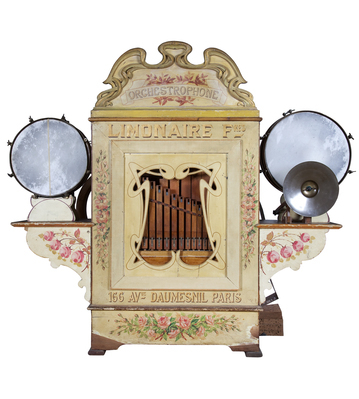Details
TitleFairground Organ 'the Little Limonaire'
CreatorLimonaire Frères
PlaceParis (France)
Year 1911
Object number1159
Object categorymechanical instruments with organ pipes
Object namefair organ, organ with book
DescriptionA wooden turning wheel, probably not original, is attached to the back. On the right side of the case, a motor has been installed; this may have been done around 1940. However, the rest of the organ, including the instrumentation and the painted front, is still entirely original.
Accompanying textsThe organ has 35 keys, a large drum coupled with a cymbal, and two sticks for the snare drum. An important purpose of a fairground organ was to attract attention and crowds, to draw paying customers towards the attractions. This organ fulfils its function well: despite its small size, it is quite loud!
This small, cheerfully painted organ - the smallest model in the Limonaire catalogue - would have been used at the fairgrounds to play music for visitors looking for excitement. In this case, the attraction accompanying the organ was probably a merry-go-round for children.
The famous Limonaire firm built not only mechanical organs, but also fairground rides and other amusements. At the beginning of the 20th century, they took advantage of the economic problems in the US, forcing the Gavioli firm to give up certain business opportunities in Waldkirch. In 1908 (just a few years before it is estimated that this small organ was built), the Limonaire firm was able to take over the premises and the stock that Gavioli had had to let go. Limonaire subsequently produced a large number of instruments and entertainment devices for the fair (such as organs combined with cinema equipment).
This small, cheerfully painted organ - the smallest model in the Limonaire catalogue - would have been used at the fairgrounds to play music for visitors looking for excitement. In this case, the attraction accompanying the organ was probably a merry-go-round for children.
The famous Limonaire firm built not only mechanical organs, but also fairground rides and other amusements. At the beginning of the 20th century, they took advantage of the economic problems in the US, forcing the Gavioli firm to give up certain business opportunities in Waldkirch. In 1908 (just a few years before it is estimated that this small organ was built), the Limonaire firm was able to take over the premises and the stock that Gavioli had had to let go. Limonaire subsequently produced a large number of instruments and entertainment devices for the fair (such as organs combined with cinema equipment).
Dimensions
geheel height: 142 cm
geheel width: 160 cm
geheel depth: 55 cm
met onderkast height: 196 cm
geheel width: 160 cm
geheel depth: 55 cm
met onderkast height: 196 cm
Digital references


